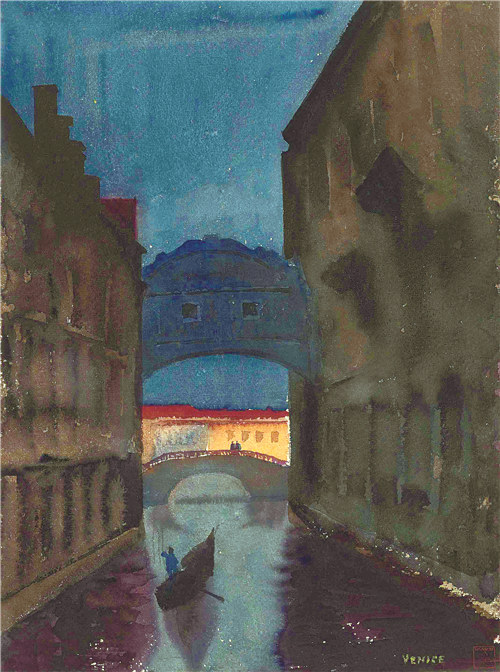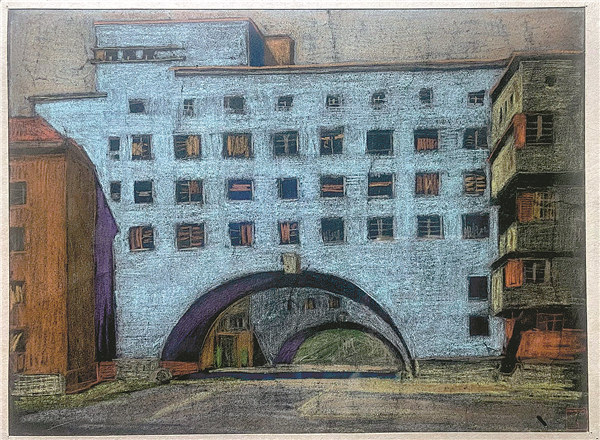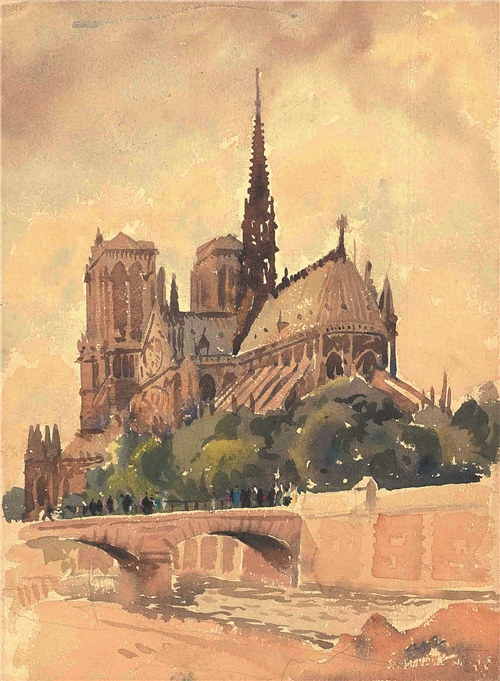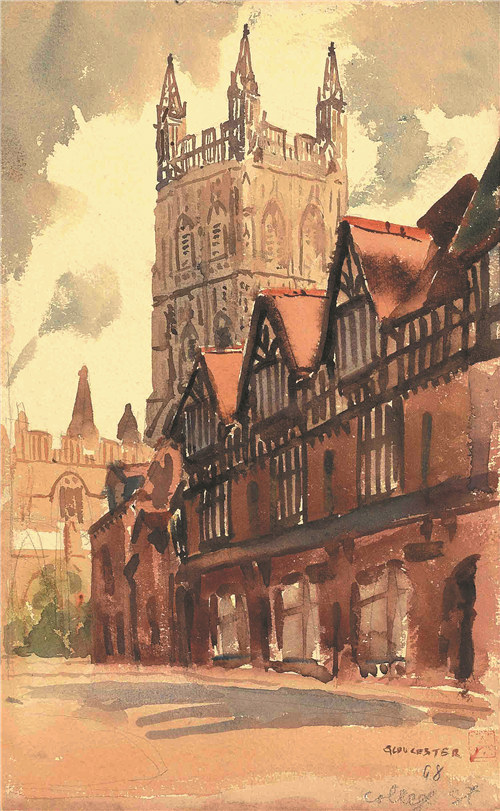Building legacies

Renowned architect Tong Jun's works, on exhibition, include A Night View of Bridge of Sighs, Venice. [Photo provided to China Daily]
An exhibition shows how architect Tong Jun's journeys of discovery constructed new links between East and West, Lin Qi reports.
If Tong Jun were alive today, he'd celebrate the reopening of Notre-Dame Cathedral in Paris, anticipated to be completed this December, with particular gusto.
The roughly 850-year-old landmark that was engulfed in flames five years ago was a favorite of the late architect and scholar. While traveling in France, he wrote about his love for this Gothic building in a diary entry dated May 23, 1930: "Notre-Dame is the most interesting. Its interior has an extraordinarily mystical atmosphere, which is accentuated by those beautiful stained-glass windows, making one feel his heart tremble. It's the best experience I've ever had."
He hailed the marvel again in another diary entry three days later, after visiting Chartres Cathedral, which he believed didn't have the same mystique.
"Everyone likes Chartres, but I prefer Notre-Dame," Tong wrote.
Tong is recognized as one of 20th-century China's "four great architects", alongside Yang Tingbao, Liang Sicheng and Liu Dunzhen. All four were trained both in China and abroad, and blended Western and Chinese practices and philosophies.
Tong's diaries bear witness to his extensive travels through a dozen countries in Europe from May to August 1930, during which he visited and sketched famed buildings.
A selection of the drawings, watercolors, diaries and photos recording that journey are on show at A Leisurely Stroll From the East to the World, an exhibition at the Art Museum of Beijing Fine Art Academy that runs through to Feb 26.
The works were shown several times last year to commemorate the 40th anniversary of Tong's passing, including at Southeast University in Nanjing, Jiangsu province, where he taught for years, and in Shanghai, where many of his designs were built.

Karl-Marx-Hof Public Housing, in Vienna [Photo provided to China Daily]
'Grand Tour'
After finishing his studies at Tsing Hua College, the predecessor of Tsinghua University, Tong went to the University of Pennsylvania in the United States, the institution that helped cultivate modern China's first generation of architects, including Tong, Yang and Liang. Tong obtained his bachelor's and master's degrees at the University of Pennsylvania.
After graduating in 1928, he worked at two firms, including that of the prolific architect Ely Jacques Kahn in New York City. Two years later, he left the job to travel in Europe, tracing the "Grand Tour" route.
The Grand Tour emerged in the 16th and 17th centuries as a popular tradition among European aristocrats, who used their wealth and leisure time to travel the continent to explore natural landscapes, art and architecture as part of their educations. The practice expanded to other social classes in the late 18th century as tourism became more affordable. In particular, young artists and architects, including those from other continents, viewed it as an ideal way to enrich knowledge, widen vision and inspire future work in their respective fields.
Tong's itinerary included Britain, France, Belgium, the Netherlands, Germany and Italy, according to a map he drew en route. He painted, wrote about and photographed magnificent classical and modern buildings, and the cultures that generated such architecture.
Liu Xiao, a curator of the Art Museum of Beijing Fine Art Academy, says the drawings and watercolors from the tour on show are not some sketches created quickly to show others he'd made the trip. Rather, they show the solid discipline Tong had received to become a qualified architect, empowered by thought and an aesthetic taste to consolidate his understanding of architecture from different periods.
Tong learned oil painting at an early age and exhibited his works while at Tsing Hua College.
At the University of Pennsylvania, he studied a curriculum that emphasized training in architectural techniques and the integration of architecture with all art forms, including painting, poetry, music and sculpture. He was taught to be an architect with aesthetic discernment.
"These artworks are displayed in the order of the countries he toured that year and juxtaposed with diaries mentioning the architecture he saw on the way," Liu says.
"This allows the audience to feel Tong's accumulation of cultural understanding, insights and research."
Tong Jun's grandson, Tong Ming, who's a professor of architecture at Southeast University, says the tour was one of his grandfather's "most glorious" life chapters.
"It wasn't hard for a trained architect like him to depict those buildings in a professional manner. But he was also able to capture their souls and distinctive auras," Tong Ming says.
"He shows us how architecture's evolution shapes the way our world looks."

Notre-Dame Cathedral, in Paris [Photo provided to China Daily]
Chinese gardens
The exhibition also pays tribute to Tong Jun's pioneering role in the study, introduction and revival of classical Chinese gardens in modern times.
After returning to his homeland in the 1930s, he mostly worked and lived in Jiangnan — the southern region of the Yangtze River's lower reaches — where he surveyed and mapped many centuries-old private garden houses.
He completed the groundbreaking An Introduction of Chinese Gardens in Jiangnan in 1937.
And he authored Glimpses of Gardens in Eastern China in 1983, the year he passed away, in English to introduce Chinese gardens' beauty and philosophy to the world. Tong Ming later translated it into Chinese and published a bilingual book.
Excerpts from the books, Tong Jun's manuscripts, and drawings and photos of the gardens are also on show.
Liu, the curator, says that after Tong Jun strolled through Europe's history and cultures, he returned home, where he went on to dig into his mother culture's roots. He rendered his studies of Chinese gardens with new perspectives grounded on his education in the US and experiences in Europe. And he traced Chinese architecture from the past to the modern world.
Tong Ming says: "He told the world that once you understand Chinese landscape paintings, you will understand Chinese gardens, too, because they're three-dimensional versions of Chinese landscape paintings.
"The flowerpots, plants, fish pools and rocks are not only works crafted to decorate the gardens. They also ...reveal people's feelings about the world. These gardens are ideal spiritual havens conceived by ancient Chinese."

Gloucester Cathedral, Britain [Photo provided to China Daily]
Related articles
-
 Colors, texts and poems, the gateways to an artist's world
Colors, texts and poems, the gateways to an artist's worldMore
-
 Chinese painter forges inimitable style after decades abroad
Chinese painter forges inimitable style after decades abroadMore
-
 Cultural and creative campus competition comes to end
Cultural and creative campus competition comes to endMore
-
 Shanghai exhibition opens celebrating artists from 1900s
Shanghai exhibition opens celebrating artists from 1900sMore
-
 Rare Works of 17th Century Artists on Show at Long Museum
Rare Works of 17th Century Artists on Show at Long MuseumMore
-
 Wang Tuo wins the M+ Sigg Prize 2023 with The Northeast Tetralogy (2018–2021)
Wang Tuo wins the M+ Sigg Prize 2023 with The Northeast Tetralogy (2018–2021)More
